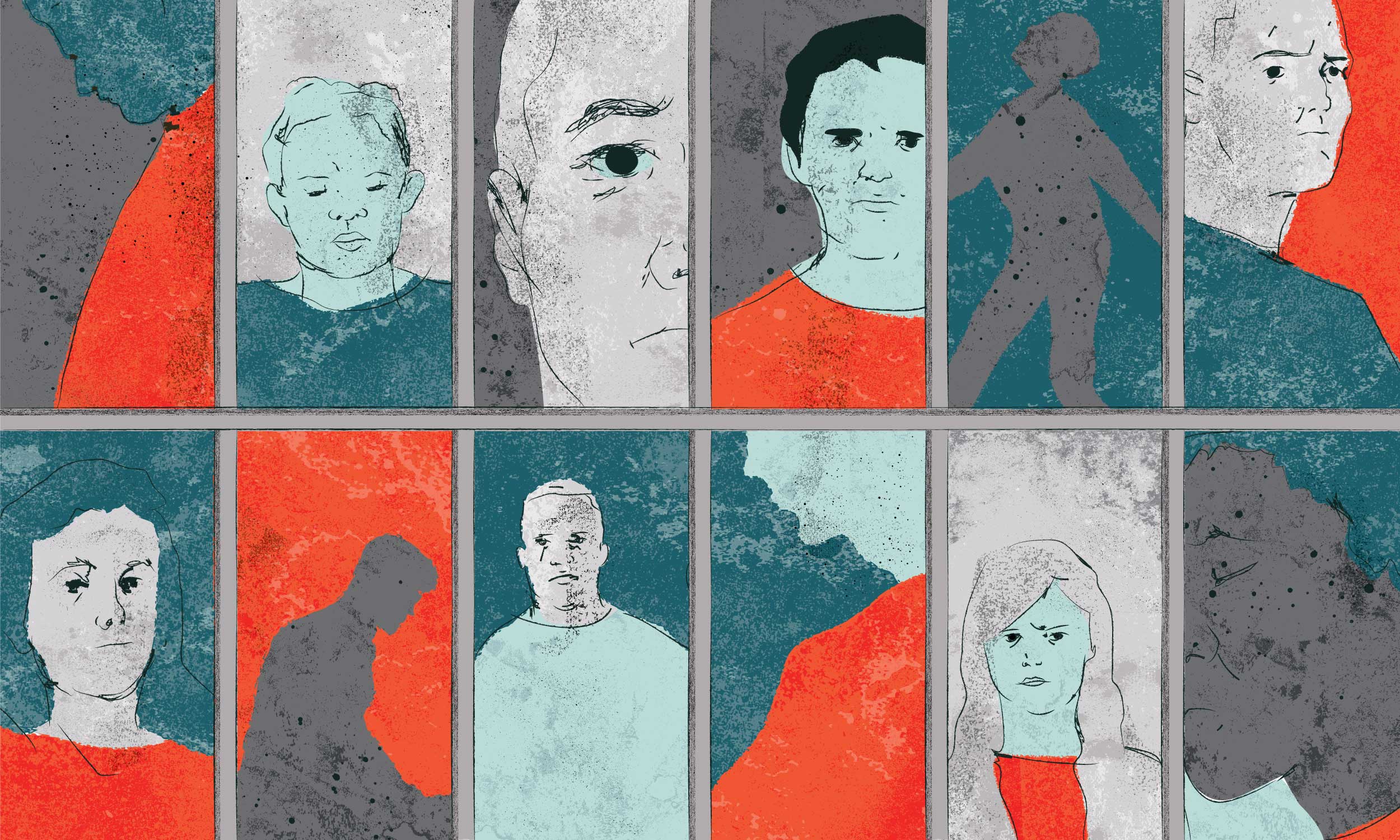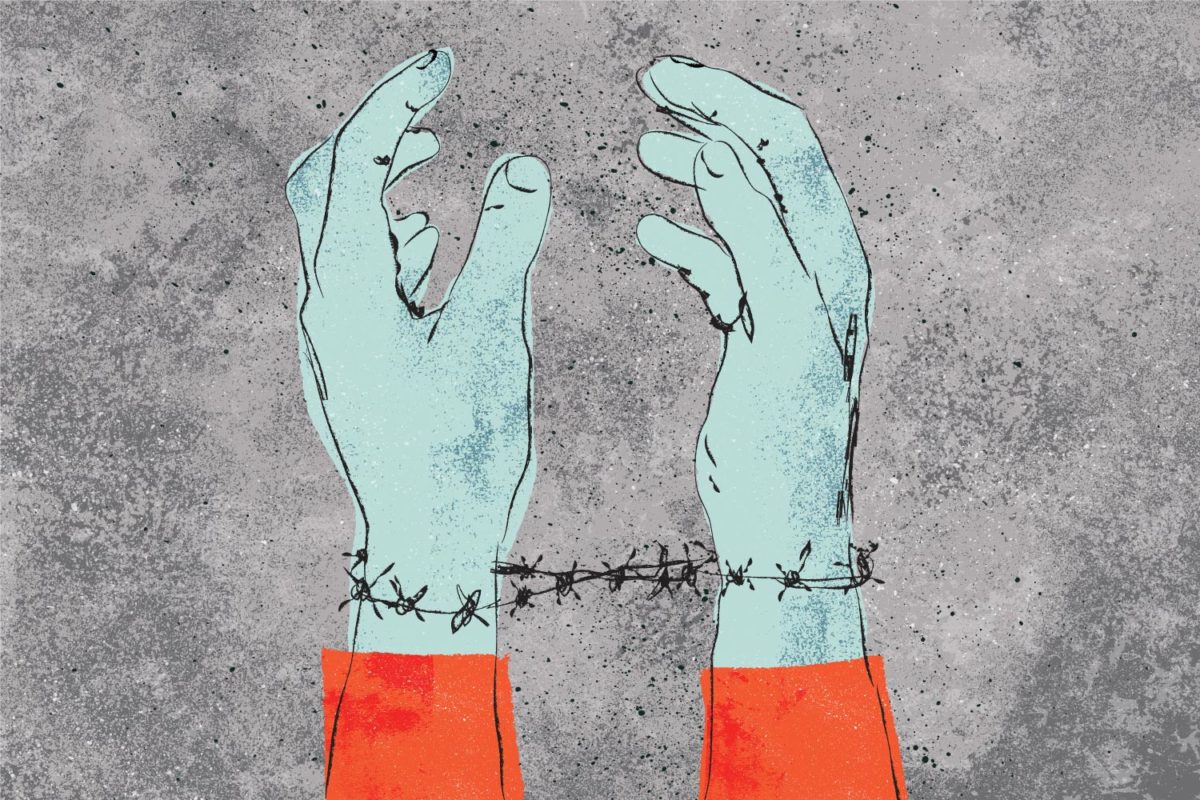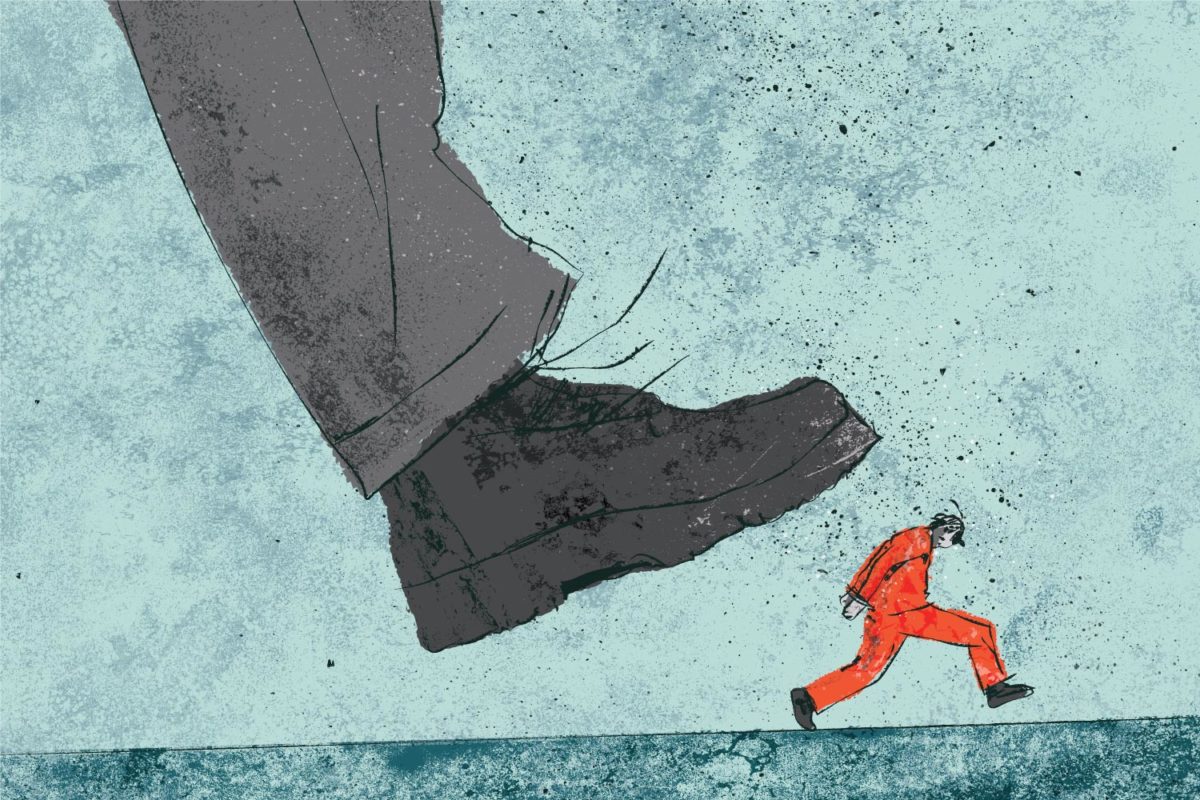In Erie County, Jail Deaths Continue Despite High-Profile Tragedy
The death of 27-year-old India Cummings in 2016 garnered national media attention and a renewed push by local activists over conditions of confinement in the New York county’s jails. But the deaths haven’t stopped.

Editor’s note: The reporter’s aunt, Nan Haynes, and father, John Lipsitz, represented plaintiffs against Sheriff Timothy Howard in 2010 and 2006. Haynes was also a plaintiff in a 2017 lawsuit compelling Howard to properly document and report prisoner suicide attempts. John Lipsitz was cooperating counsel on the New York Civil Liberties Union’s 2014 lawsuit against the Erie County sheriff’s department for Freedom of Information Law (FOIL) violations.
On July 31, 2019, Connell Burrell collapsed at the Erie County Holding Center in downtown Buffalo, New York. A slightly built 44-year-old man with Type 2 diabetes and chronic obstructive pulmonary disease, Burrell had served just 12 hours of a 15-day sentence on a disorderly conduct charge when he crumpled to the floor. He was eventually transported to Buffalo General Medical Center; by the morning of Aug. 2, he was dead.
Although there has been no official finding in Burrell’s death—the New York State Commission of Correction is still investigating—he appears to have died from medical neglect. His blood sugar spiked before jail employees administered a dose of insulin, then it dropped to dangerously low levels. Jail medical staff gave him a peanut butter sandwich in an effort to drive his blood sugar level back up. But the sandwich, which Burrell was too sick to chew or digest properly, impeded attempts by ambulance medics to force air into his lungs. A jail nurse was later fired over Burrell’s treatment.
Burrell was living with his younger sister and her children at the time of his death. Another sister, Monica Lynch, told The Appeal that Burrell was “more of a father figure than an uncle” to his little sister’s children: “He stepped in, played with them, took them to the bus stop, picked them up after school sometimes.” Burrell also had a child of his own, a boy who turned 17 in November.
Despite struggling with physical disability, alcoholism, and the early loss of his mother, Lynch said her brother was “a nice, considerate person, willing to do anything for anyone.”
On average, one person dies every six months in Erie County jails. The Erie County Holding Center in downtown Buffalo has a 638 person capacity and processes over 20,000 people each year. The Erie County Correctional Facility in Alden, New York, can hold approximately 884 people. Since the appointment and subsequent election of Sheriff Timothy Howard in 2005, 30 people have died in the county’s jails. In 2019, four people died: Joseph Bialaszewski, 29, in July; Burrell in August; Daniel Spicola, 40, in September; and Robert Ingalsbe, 33, in October. Ingalsbe and Spicola appeared to have died by suicide.
When the county legislature submitted Freedom of Information Law requests to the state Commission of Correction last summer, it uncovered two more 2005 deaths that occurred during Howard’s tenure: Erie County Correctional Facility prisoners Nathan Frailey and Daniel McNeil. The commission, however, redacted the cause of death in these cases, as well as details surrounding the June 17, 2005 death of Ethel Ridgeway at the correctional facility. Ridgeway died about one week before Howard was appointed sheriff in late June 2005.
Every Wednesday since 2009, local activists have gathered, usually in front of the holding center, to protest the conditions in Howard’s jails. “There are times when there have only been four or five of us, and times when there are 20,” Karima Amin, founder and director of the Buffalo-based advocacy group Prisoners Are People Too, told The Appeal. “Most people don’t know or care until something big happens or it ends up on their front porch.”
As of January 2018, Erie County taxpayers spent nearly $2.5 million settling lawsuits that arose from deaths, injuries, and illnesses at its jails. A February 2018 report by the Commission of Correction found Erie County jails to be among the “most problematic local correctional facilities in the state.” The commission is investigating the deaths of Burrell, Spicola, Ingalsbe, and Bialaszewski. Burrell’s sister told The Appeal her family is in the process of filing a lawsuit. The father of 33-year-old Michael Girard, who hanged himself in the holding center in May 2018, filed a wrongful death suit against against Erie County and Sheriff Howard in May 2019.
Erie County District Attorney John J. Flynn’s office has not investigated a death in a county jail since Flynn was elected in 2016 because one of his prosecutors is married to a sheriff’s deputy. In 2018, Flynn recused his office and asked the state attorney general to investigate the 2016 death of 27-year-old India Cummings at the holding center. (The attorney general’s office did not respond to repeated requests for comment on the status of that investigation.)
A spokesperson for the DA’s office wrote in an email to The Appeal that she is “not aware of any investigations into deaths in Erie County jails prior to DA Flynn taking office.” In February 2019, Cummings’s family filed a federal civil rights lawsuit against dozens of sheriff’s office employees, claiming that “the above-captioned Sheriff Deputies, Sergeants, and Lieutenants assigned to observe Cummings literally watched her die.”
Under the state Constitution, Governor Andrew Cuomo has the power to remove sheriffs from office, and in October, a group of activists called for Howard’s removal. The governor’s office did not respond to repeated requests from The Appeal for comment.
Howard was re-elected in 2009, 2013, and, by a slender margin, in November 2017. He will be up for re-election in 2021. The Appeal asked the sheriff’s office about the conditions of confinement in Howard’s jails, the continuing deaths there, and the multiple lawsuits over those deaths. Scott Zylka, a sheriff’s office spokesperson, declined to comment and referred requests for comment on litigation to the county attorney’s office.
The county attorney declined to comment and referred The Appeal to the county executive’s press secretary, Peter Anderson. Anderson wrote in an email that “while we cannot and would not speak on behalf of the Sheriff’s office, we can say that the condition of [Erie County] jails meets all New York State Commission of Corrections standards. Our administration is responsible for the administration of forensic mental health services at the Erie County Holding Center and the jail (2 separate facilities) and we have increased investment in that area to provide the best mental health services possible, including building a new re-entry Hub as part of our forensic mental health division location next to the Holding Center.” Asked about the seven lawsuits filed against Sheriff Howard in 2019 alone, Anderson noted that not all of the lawsuits were “jail-related.” (four of the seven are related to events that allegedly occurred in an Erie County jail.)
In an October interview, Howard cited a Department of Justice report that found his jails were in substantial compliance on security and correctional health. “Despite the deaths of certain inmates,” he said, “we have done our part to try to prevent that from happening.” He also said that half the deaths in his jails are suicides and “the person most responsible for a suicide is the person that commits the suicide.”

People are often incarcerated at the Erie County Holding Center for minor offenses, including “mouthing off” to a cop, smoking a joint in the park, driving with a suspended license, or videotaping the police during a loved one’s arrest, Legal Aid Bureau of Buffalo attorney Miles Gresham told The Appeal. It’s a pretrial facility, meaning that most people held there are not convicted of a crime and are therefore legally innocent. According to the New York State Division of Criminal Justice Services, most people arrested in the county are Black and Latinx.
By that measure, Julie Marinaro, a white woman from an affluent Buffalo suburb, would be an unlikely candidate for arrest and detention. But in 2014, sheriff’s deputy Kenneth Achtyl pulled her over for a minor traffic infraction in Chestnut Ridge Park. Marinaro told The Appeal that her nanny was driving at the time and, irritated by Achtyl’s demeanor, Marinaro said, “Just give us the ticket.”
“That’s when all hell broke loose,” she said. “He did not want to be told what to do. He needed to exert his authority in another way … As soon as he saw he had nowhere to go with his bullying techniques, that he’d lost his authority, it made him insane.” Instead of issuing a ticket, Achtyl kept Marinaro, the nanny, and three of her children waiting in the car for 42 minutes.
Marinaro said that when she attempted to use a nearby restroom, Achtyl ordered her to remain in the vehicle and said he didn’t care if she urinated on herself. After Marinaro refused to get back into the car, Achtyl handcuffed and arrested her in front of her children. Seconds later, her Lycra pants were soaked with urine.
Achtyl then charged Marinaro with obstructing governmental administration and took her to the holding center. Marinaro said that when her husband arrived at the jail to bail her out, employees told him she wasn’t there. Marinaro recalled that the facility was “disgusting” and that basic information was withheld from incarcerated people, food lay on the floor, and the staff was “rude and condescending.” Marinaro recalled that when a staffer filled out an intake form, he asked for her highest level of education. “I said ‘master’s,’ and the guy looks up and said, ‘So you think you’re better than everyone? That’s what I heard about you.’”
“My whole thought the entire time was, ‘I’m going to sue the hell out of these people,’” she said. “I found out later it has one of the highest suicide rates in the country for a holding center. I thought I was a strong woman, but after 24 hours, I would have taken my own life.”
In the end, Marinaro was incarcerated for about 24 hours and she took an adjournment in contemplation of dismissal in her case, which allows a court to defer the disposition of a person’s case, with the potential that the charge will be dismissed if the person doesn’t engage in additional criminal conduct. Marinaro said that she considered suing the county over her treatment but was “definitely afraid of retaliation.” Now, five years after her arrest, Marinaro said she regrets not suing “because not only did he do that to me, he did it to someone else.”
That “someone else” was University at Buffalo student Nick Belsito. In December 2017, Belsito and a group of friends were tailgating outside a Buffalo Bills game when one of the tailgaters threw a beer can into a crowd. The can hit Achtyl on the elbow. Achtyl arrested the person who threw the can, and Belsito asked where he was being taken. At first Achtyl tried to shoo Belsito away, in part by threatening him with arrest; eventually, Achtyl said, “10 Delaware,” the address of the Erie County Sheriff’s Office. Belsito, however, is not a Buffalo native, so he didn’t recognize the address. Achtyl then told Belsito to “Beat it.” Belsito replied, “What do you mean, beat it? You’re a fucking cop!”
According to footage from Achtyl’s partner’s body camera, a cell phone video taken by a young woman at the scene, and eyewitnesses, Achtyl then got out of his vehicle, chased Belsito, placed his baton on Belsito’s neck and dragged him back to the vehicle, where he beat him in the head, leaving Belsito with a concussion and a broken nose. After the beating, Achtyl arrested Belsito, joked about his injuries—he nicknamed him “Mr. Bloody Face”—and charged him with disorderly conduct, obstructing governmental administration, and criminal mischief.
In June 2018, prosecutors with the Erie County district attorney’s office dismissed the charges against Belsito after reviewing the body camera footage. Prosecutors then brought a criminal case against Achtyl, and in September 2019 a jury convicted Achtyl of reckless assault, official misconduct, and falsifying business records for lying about his encounter with Belsito on an arrest form.
Sheriff Howard attended Achtyl’s trial as a show of support for the deputy and maintained that because Achtyl was convicted of misdemeanors and not felonies, he would not automatically be fired. Erie County DA Flynn told The Appeal that the sheriff’s office “should have fired him,” because under New York State’s Public Officers Law, “they didn’t have a choice.”
Belsito sued Achtyl, Sheriff Howard, and Erie County. The complaint, which remains open, was removed from New York State Supreme Court and filed in federal court in February 2019. Achtyl is also one of three sheriff’s deputies being sued by a different man for allegedly assaulting him during a 2018 traffic stop.
At a March meeting of the county legislature’s Public Safety Committee, Sheriff Howard was asked about the possibility of deputies being required to wear body cameras, an idea that won support among local legislators after Belsito’s beating. Howard replied by likening support for body cameras—which he characterized as “we don’t believe you—die for us, but we don’t believe you”—to those who doubted the resurrection of Jesus.
In October, the Buffalo News reported that Achtyl resigned from the Erie County sheriff’s office and back-dated his resignation letter to make it appear that he had submitted it before conviction. In an email to The Appeal, Chief John Greenan of the Administrative Services Division of the sheriff’s office wrote, “Deputy Achtyl retired prior to his conviction and therefore was reported as such.” When asked to clarify whether Achtyl retired or resigned, Greenan replied that he retired. It’s not clear why Achtyl chose to do so. The state comptroller’s office did not respond to a request for comment on whether a 46-year-old sheriff’s deputy who retired after 19 years would qualify to draw a pension.
Achtyl is scheduled to be sentenced in the Belsito case on Jan. 23. His attorney, Albert J. D’Aquino, wrote in an email that although Achtyl “appreciates” The Appeal’s outreach, he cannot comment on the Belsito or Marinaro matters, due to pending litigation in the Belsito case and on the advice of his attorneys. D’Aquino added that, according to Achtyl, it “would not be fair or warranted” to construe his unwillingness to comment “as anything other than my resolve to follow the advice of my attorneys.”

This month, Erie County’s Corrections Specialist Advisory Board will begin meeting. Gresham, the Legal Aid attorney, was appointed to the board and told The Appeal that one of his priorities is “reforming the way people who are in mental distress or having mental health problems are treated in the Holding Center, and how well they’re taken care of in the Erie County Medical Center (ECMC), or while being transferred between ECMC and the Holding Center or vice versa.”
The 2016 death of India Cummings—she suffered a mental breakdown and, after refusing food and medication and flooding her cell, was seen babbling, smearing food on herself, and lying in a pool of her own urine—brought national media attention to Erie County and scrutiny of its jails, making the board’s work all the more urgent.
But the deaths did not stop. On July 26, 2019, just one week before Connell Burrell’s death, Joseph Bialaszewski died at the Buffalo General Medical Center after being found unresponsive in his holding center cell. His mother was told that her son died of a ruptured ulcer that led to sepsis and cardiac arrest. Bialaszewski was incarcerated on a parole violation, then charged with obstructing governmental administration and resisting arrest. The mother of his child’s mother told the Buffalo News that his arrest left him with five stitches over one eye. (It’s not clear whether the arresting officers suffered any injuries.)
Although Bialaszewski had complained of feeling ill, jail employees placed him in a remote detox cell away from medical staff and not in constant view of guards. The doctors who treated him at the medical center discovered that he had been bleeding internally from a perforated ulcer. They couldn’t say with certainty how long he had been lying unresponsive on the floor of his cell before jail staff found him. “They would have seen that he was just laying there in pain, and maybe they could have saved his life,” Gail Bialaszewski, his mother, told the Buffalo News.
Monica Lynch, Burrell’s sister, told The Appeal that she empathized with the Bialaszewski family. She helped raise funds for Gail Bialaszewski when Bialaszewski couldn’t afford the $900 required to collect her son’s ashes from a local funeral home. She “needed some closure,” Lynch said.
Lynch told The Appeal that she has seen Sheriff Howard in person only once since her brother died and that he ignored her. “He never said one thing out of his mouth about none of the people at the holding center,” she said. “He never apologized to none of them, to anybody.”
When a person is born, Lynch said, everybody wants the best for them, “like in the movie, ‘The Lion King.’ I don’t understand how 20-30 years down the line, people don’t see them like that.”
She said her brother was a human being “and all of these people, the 29 other deaths—they weren’t just numbers, they were human beings, too.”
“Every time we take a step and kill an ant,” she added, “we don’t know how the ant died or nothing. Because they’re so small, you can’t see. People treated my brother like an ant. But every life amounts to something.”
